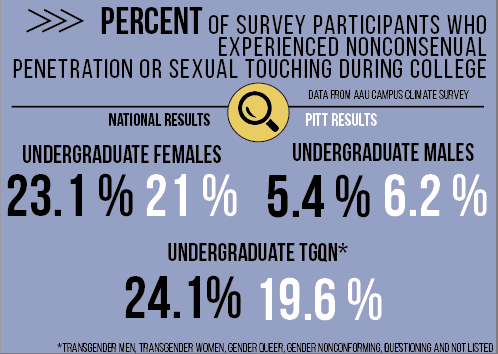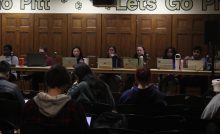Pitt releases sexual assault survey results


Emily Hower / Layout Editor
When it comes to sexual misconduct on Pitt’s campus, students are afraid to step in, seek help and file reports, according to a survey of the University’s sexual climate.
The results of the 2015 Campus Climate Survey on Sexual Assault and Sexual Misconduct, which Pitt released Monday, showed that female students and transgender or non-gender conforming students were more likely to experience harassment or sexual assault on campus. While many respondents were aware of resources on campus like the Wellness and Counseling Centers, many didn’t know what would happen after they reported an assault.
Pitt was one of 27 colleges in the Association of American Universities that surveyed its students from April 22 to the end of May on the prevalence of sexual misconduct on campus. A total of 6,234 students completed the survey for a response rate of 19 percent campus wide.
Roughly 20 percent of Pitt female undergraduates and graduate students who responded to a sexual climate survey last spring said they have experienced “nonconsensual penetration involving force or incapacitation or sexual touching” during their college careers.
Responses from male respondents showed that 6.2 percent of undergraduate men and 1.3 percent of graduate men were victims of nonconsensual sexual penetration or touching. Male students were generally more optimistic than women and transgender or non-gender conforming students about reporting incidents of sexual assault to the University and were less afraid of retaliation from their offenders.
Pitt released the entirety of its survey, as recorded by research firm Westat, in a 129-page report with an additional 92 pages of data tables.
According to the national results, 47.7 percent of students who took the survey “indicated that they had been victims of sexual assault” since entering a higher institute of learning. At Pitt, more than 63 percent of forced sexual assault incidents occurred on campus, with almost 70 percent of students responding that an incident that occurred on campus property happened in a University hall or dormitory.
The number of female undergraduate students at Pitt who participated in the survey and were victims of nonconsensual penetration or sexual touching for the current school year, was 11.7 percent. For male undergraduates that number was 3.4 percent. Among all 27 AAU schools, female undergraduates who said they were victims of nonconsensual penetration or sexual touching during the current school year was 13.2 percent, while male undergraduates reported 3.3 percent.
The results indicated that women and members of the transgender, genderqueer and non-conforming community are most at risk of sexual assault.
By senior year, 23.6 percent of female undergraduates reported experiencing nonconsensual penetration or sexual touching by force or incapacitation.
“Sexual harassment and violence have no place in our university. We need to take aggressive actions to address this important national issue on our campus, and the survey will give us the data we need to focus our efforts,” Chancellor Patrick Gallagher said in the release.
At Pitt, 11.2 percent of heterosexual students reported they had been a victim of sexual assault, compared to 15.2 percent of non-heterosexual students. Nationally, 60.4 percent of non-heterosexual students reported being sexually harassed, compared to 45.9 percent of heterosexual students.
The survey also examined how likely students who had experienced or seen sexual assault or misconduct were to report the incident to University or health officials.
Almost 40 percent of female and male undergraduates who responded to the survey thought that the University was “very” likely to conduct a fair investigation of the incident, compared to roughly 18 percent who thought a fair investigation was “extremely” likely. The most common reason for not reporting an incident of sexual assault was shame or difficulty dealing with the emotional consequences.
In contrast, the highest percentage of transgender, genderqueer, non-gender conforming or questioning undergraduate students responded “somewhat” likely in response to questions about whether the University would conduct an investigation.
Roughly 23 percent of TGQN respondents said they didn’t think the University would protect the safety of the person making the report at all.
Marcus Robinson, the president of the Rainbow Alliance at Pitt, said this is because there’s typically a distrust for administration among marginalized groups.
Robinson said he doesn’t place any blame on the current administration. He added that he’s seen a lot of positive change in the University’s efforts to address sexual assault on campus this year, including the creation of the Office of Diversity and Inclusion and the numerous sexual assault awareness events.
“All the events during orientation are going to be helpful moving forward,” Robinson, a junior anthropology and neuroscience major, said.
While around 80 percent of undergraduate male and female students said they knew about resources the Wellness Center and the Counseling Center offers, 40 percent said they were not at all knowledgeable about what happens when a person reports an assault. Eighteen percent of female and male undergraduates knew about the Title IX Office and/or the Office of Diversity and Inclusion.
According to University spokesperson Ken Service, Pitt is planning to bolster awareness of its available and less well-known resources.
Service said Pitt is putting together a program to address the issue in a holistic manner that involves students, faculty and staff. He could not give specifics of the program but said it would include a combination of education and prevention methods as well as making students aware of the resources available to them, such as the new Title IX office and the bystander intervention training.
Service said there would not be an official release date for this program — rather, it would be an “evolutionary process.”
“Any one incident of that sort is one more than we should have,” Service said. “We have to change the culture of this institution.”
Suzy Hinkle, president of the Campus Women’s Organization at Pitt, said the numbers regarding how many people did nothing were “shockingly high.”
Among the bystanders to situations that involved a drunk party, a total of 79.7 percent indicated that they did nothing.
“Pitt is definitely doing a lot to change how sexual violence is treated at the administrative level and at the cultural level, but we have far to go,” Hinkle said.
Robinson said it’s the responsibility of everyone on campus to be a part of a supportive culture regarding sexual conduct.
“The stuff in [the report] is serious and incredibly disappointing to know,” Robinson said. “I think it’s everyone’s responsibility — people who attend this campus, it’s our job to look out for each other.”
Recent Posts
Review | Delayed checkouts at ‘The White Lotus’: An unoriginal third season
(Contains Spoilers) There is no meditation class, no reiki session, no nutritionally balanced, organic food…
Celebrating Women’s History Month with the HerStory Slam Event
Idaya Sasikumar, a first-year psychology student, took to the stage to read her personal story.…
Review | Michael Franti & Spearhead reflect on the power of love in new album ‘Welcome to the Family’
Nothing says “Welcome to the family!” like a new baby. Soul-rock band Michael Franti &…
How hurling put me on ESPN and in a National Championship game
Nothing is more difficult than joining a new club in college. It is terrifying when…
Column | It’s now or never for Henry Davis
When Henry Davis came into Monday night’s game against the Washington Nationals at PNC Park,…
Pitt men’s basketball navigating transfer portal difficulties
Pitt men’s basketball is like any other team in the world of large NIL deals…

